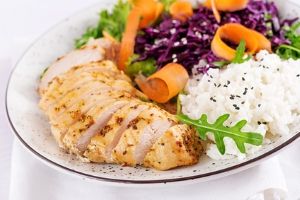What is metabolism?
The word metabolism comes from the Greek « metabolismos » which means « change » or « transformation ». Metabolism is the set of reactions occurring in the cells of our body. It involves:
- Catabolism, a destructive process producing energy from the nutrients absorbed by degrading relatively large and complex molecules into smaller and simpler ones (energy spent for usage and storage);
- Anabolism, a destructive process synthesizing elements needed by our cells to function (e.g. destocking of reserves).
The term is often used to talk about a person's energy expenditure.
Metabolism is influenced by three factors:
- The basal metabolic rate (BMR) or basal metabolism
- Physical or intellectual activities
- Digestion
Metabolism can be increased by acting on these three parameters, especially the last two.
Other factors such as fighting against cold or heat, smoking or drinking coffee affect metabolism. The latter is also influenced by the level of thyroid hormones which can affect its value by plus or minus 10 %.
The basal metabolic rate
The basal metabolic rate (MDB) or basal metabolism corresponds to the minimum activity necessary for our body to survive. In practice the basal metabolism is associated to the amount of energy we expend at rest, awake, at normal temperature (no fight against heat or cold), to guarantee vital functions: keeping organs running, maintaining body temperature, ensuring cell renewal, allowing muscle activity, etc.
The basal metabolism depends on several factors: sex, height, weight, age. The taller and stronger a person, the more cells are to feed, the higher the energy spent. Men tend to consume more calories than women because they have more muscles.
On top of these basic parameters considered in empirical formulas for calculating the basal metabolic rate of a person, there are others such as weather conditions, physiological state (emotions, pregnancy, etc.), food habits. It is therefore difficult to alter its value significantly. We will see how regular physical activity and weight training increases basal metabolism.
To give an example, the basal metabolism of a 35 year old man weighing 70 kilos and measuring 1 m 75 is approximately 1665 kcal. That of a woman of similar age weighing 60 kilos and measuring 1 m 65 is approximately 1370 kcal.
The basal metabolic rate falls fairly rapidly at youth and stabilizes in adulthood (around the age of 20 for women and 30 for men). It then drops by 2% every 10 years from the age of 40 because of muscle wasting.
Basal metabolism represents approximately 60-75% of the energy expenditure of a person physically inactive.
Physical and intellectual activity
Daily gestures, the fact of thinking, talking, moving are as many acts consuming energy in addition to the basic metabolism. These activities represent approximately 15 to 30 % of our total expenditures. Obviously, more physical activity means more metabolism. Sport or a very physical work will boost it!
Digestion and thermogenesis, or how to expend calories in order to store some!

Our body expends energy and generates heat during digestion. This is called postprandial thermogenesis. About 10 % of daily expenses are due to digestion. Basically, expending energy is necessary in order to store some! This means less calories stored! One could think there could be a way to expend more calories than the calories brought by the food absorbed. Unfortunately not!
Some foods, however, require more energy than others to be digested. We'll see what food in the next sections.
Why and how to increase metabolism?
Losing weight: a matter of balance
When the number of calories absorbed from food is greater than the metabolism rate, i.e. the number of calories burnt, the surplus gets stored as fat. To stay slim or even lose weight, more precisely fat, the right balance must be found between reducing calories, increasing metabolism, or doing both!
Increasing metabolism means increasing energy expenditures, in other words burning more calories.
Physical activity and specific nutrition help increase metabolism
Physical activities (sport, outdoor games, etc.) naturally increase metabolism: to meet the needs of the moment, our body dips in its reserves to feed muscle cells. Catabolism takes place. Physical activity, on a longer term, increases the basal metabolic rate.
Eating does not just bring calories: digestion has an energy cost which is more or less depending on the food absorbed. In the next section we give a few tips to effectively increase metabolism with specific food.
Losing fat at rest!
Increasing basal metabolic rate is equivalent to burning more calories at rest, doing nothing, when sleeping for example! It is also at rest that our body burns the most fat in proportion of degraded substrates (see our article on how to effectively burn fat). An increase of 1 % of its value would allow to expend, depending on age, weight and sex, between 10 and 20 kilocalories more per day, i.e. from 3600 to 7300 kcal or 350 to 700 grams of fat!
Tips to increase metabolism
Concretely, and is the subject of the next sections, metabolism can be increased by:
- Changing eating habits
- Performing appropriate physical activities
- Adapting lifestyle
The influence of foot on metabolism
I eat, therefore I'm losing weight!
Eating less to reduce the number of calories absorbed seems a sensible idea but is not sufficient to lose weight because metabolism adapts accordingly, a bit like
if it were saving energy. You will certainly lose a few pounds the first few weeks following such a diet but it will become more and more difficult afterwards.
Moreover, the kilos lost will quickly be gained back once deprivations have ended, our body storing the extra calories no longer needed.
Eating the right food
Some food is more difficult to degrade than other. This is the case of complex carbohydrates (flour, etc.) and proteins. Our body expends more energy to digest such food than lipids for example, simple structured and stored almost as they are. Thus, considering only the energy value of foodstuffs is to be taken with care since, in the end, the number of calories stored also depends on the type of food. To take an example, a 100 kcal portion of butter will make you gain more weight than a 100 kcal steak because degrading the proteins of steak is harder than just storing the lipids contained in the butter.
Here is an indication of the percentage of energy consumed to assimilate nutrients:
- Proteins: 18 to 25 %
- Carbs: 4 to 7 %
- Fats: 2 to 4 %
According to these figures our body burns 18 to 25 kilocalories to digest 100 kilocalories of lean meat, some of the energy being spent in heat. Only 70 to 80 kilocalories are stored or used for the functioning of our body. Only 2 to 4 kilocalories are expended to assimilate 100 kilocalories of fat.
Eat more often!
This idea seems marginal but it is quite serious provided of course you do not eat more in quantity! Smaller but more frequent meals provide a steady source of energy, thus increasing thermogenesis. Plan 4 to 5 meals per day at fixed times by adding 1 or 2 meals where you will eat lean proteins (lean ham, dairy products) or complex carbohydrates (cereals, fruit).
Avoid keeping your stomach empty: this slows down metabolism dramatically.
Do not skip meals, especially breakfast. Breakfast is very important because it wakes your body up and boosts your metabolism slowed down by a night's sleep. Avoid fats and prefer complex carbohydrates for they are less caloric and increase thermogenesis. Eat fibers (cereals, preferably whole grain). These take more time to be digested and will keep you away longer from starving.
Find the balance between carbs, proteins and fats

If proteins help thermogenesis, it does not mean you can eat them in excess. Your meals must contain a good balance of nutrients the body needs to function, i.e. 30 % fat, 55 % carbohydrates and 15 % proteins. In general, and outside strength training more demanding in proteins, it is recommended not to eat more than 0.8 grams of protein per kilogram per day, i.e. 55 grams for a 70 kg person or 180 to 280 grams of meat per day (meat contains between 20 and 30 % of proteins). Avoid fatty meat (pork, sausage, etc.).
Drink water! A deficiency in water slows down metabolism.
Hydrate by drinking water regularly throughout the day, especially if you exercise (see our article about hydration and athletic performance).
Metabolism, including lipolysis (fat breakdown), requires water to work effectively. If you do not drink enough, your metabolism will slow down. Furthermore, by
filling the stomach, water gives a feeling of satiety. It cleans and drains the impurities. It is essential to the elimination of toxins and lactic acid produced during the effort and responsible for body aches and cramps.
Eat the right food
Some foods are known to increase metabolism, for instance methylxanthines like the caffeine (coffee, cola, etc.), green tea extract also known for its anti-oxidant effects and widely used in diet programs. Apple cider vinegar, garlic, honey, nuts, fish oils are also interesting. You can find other products in specialized stores like the L-carnitine or Coenzyme Q10 (CoQ10). Beware of contraindications, consult your doctor for advise.
(source: Hepatothermic therapy of obesity: rationale and an inventory of resources, McCarty, 2001, vol. 57, no3, pp. 324-336 (169 ref.))
These articles may also interest you
Sports nutrition: easily create your own 100% personalized food program
The 5 best food supplements to improve sports recovery
Running: 10 mistakes to avoid when starting out
Photo credit : Adobe Stock. This article contains commercial links.







